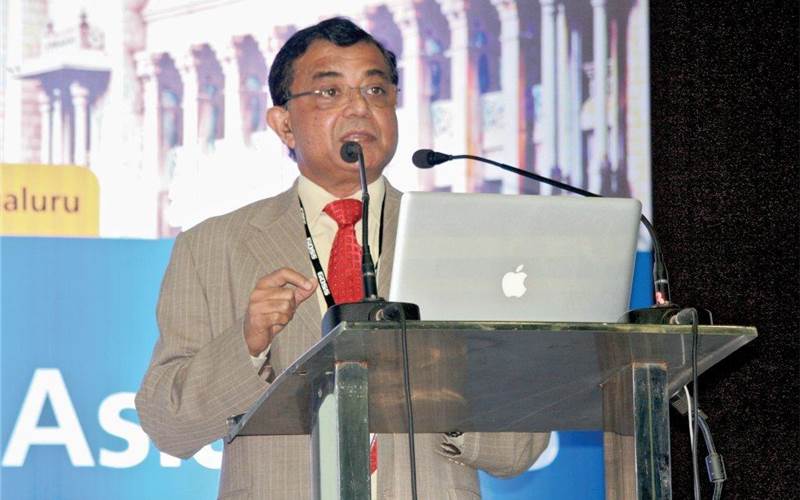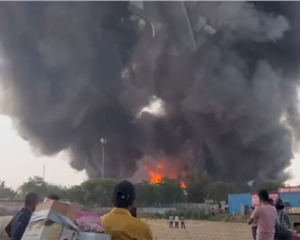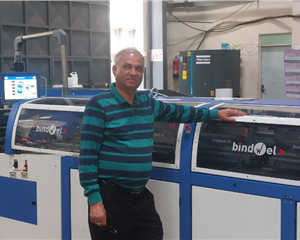Dipankar Das Purkayastha, managing director and chief executive officer of ABP – the PrintWeek India Newspaper Company of the Year 2013 – in a freewheeling conversation with Rahul Kumar.
Rahul Kumar (RK): India has been one of the markets where newspapers have registered growth.
Dipankar Das Purkayastha (DDP): The newspaper industry in India is performing much better in contrast to the severe economic slowdown in the European. In USA, newspapers have almost vanished from the market. Europe too hasn’t been clocking encouraging growth numbers. Contrary to this, South Asia or South East Asia, the condition is entirely opposite. Print has been growing; and this growth is not just in terms of revenue but extends to the numbers of titles, editions, pages, advertisements and even circulation.
RK: Even so, many top brands companies have slashed their advertising budgets. How difficult has it been for ABP to sustain in the market?
DDP: Advertisers are lesser in numbers in most of the developing economies. And most of them split their advertising budgets between print and television media. Print and TV advertisement revenue has been growing at a healthy CAGR of 15% and 18% till 2009. After that, it has been significantly down. Therefore, those media houses which do not have an electronic media property have been facing tribulations. Since the last two years, the slowdown is there but it is purely a consequence of the economic downturn.
RK: What could be the possible reasons for the growth of the newspapers in India and China?
DDP: Not just in India and China but most part of the Asia has registered growth. Countries like Indonesia and Thailand are also growing well. In the context of India, newspapers’ penetration in the country is very low as compared to other parts of the world. In India, it is around 14%, while in Europe it is more than 85%. This leaves a big headroom for growth in our economy. Secondly, the cover price of newspapers in India is very economical. Indian newspapers are priced lowest in the world at the moment. A newspaper cover price in UK is around Rs 90. Even newspaper prices in countries like Pakistan and Bangladesh are much higher as compared to India. Newspaper publishers have found it impossible to increase it because of the market pressure. On the other hand, our raw material cost is more since we import materials from USA, New Zealand, Canada, Russia and other countries.
The main thing is, the masses can afford a newspaper in India. It is the USP of Indian market. Free home delivery is another important reason, when you are getting a 20 (or more)colour pages in your newspaper delivered at your doorstep without any additional charges. Therefore why wouldn’t you opt for at least one or many more than one newspaper. Taking a cue from the decline of the newspaper industry in Europe, Indian newspaper publishers have already taken stakes in electronic, mobile and new media.
RK: So do you expect to see the growth story continuing in 2013-14 or do you foresee decline in the advertising revenues?
DDP: The current economic scenario in the country will impede the growth. In India, around 70-80% of the revenue of regional language newspapers is obtained from advertisements. In English, the dependence on advertising goes to as high as 85%. Earlier, the newspaper industry was growing at 15-16% but now it has plummeted to 4-5%. Nonetheless, I feel this is a temporary phenomenon, and growth will be back on track. The Indian newspaper industry is around Rs 18,000-crore.
RK: One of the directors of a regional newspaper publication claimed that after every 17 kilometres they have a separate edition. Your comment.
DDP: All the newspaper publication houses are becoming local and hyper-local. Hyper-localisation is directly proportional to the increasing rate of literacy in the country. Most of the metros and mini metros are nearing their saturation points. Thus, the most logical step forward is to focus on villages and be more local. Newspapers have district and town level editions. About 15 years ago, this was not the norm. Anandabazar Patrika, the Bangla daily already has 15 editions and we plan to take the number of editions to 40 or 50.
RK: How effective is hyper-localisation of newspapers?
DDP: This is a win-win situation for advertiser, reader and newspaper publisher. Earlier advertisers who wanted to advertise in one of the districts had no option but to advertise in the main edition that was circulated across the state. With hyper-local editions, he can advertise in local edition with low cost and investment.
RK: What have been the major thrust points for ABP when adopting this approach?
DDP: According to me, every electoral constituency must have a separate edition of newspapers. The idea is to cover local news in these editions because national news can be covered by television. The complete edition should carry few national; sports, regional, business, and politics news with more focus on content with a local connect.
RK: How much has the Rupee devaluation affected the newspaper industry?
DDP: Devaluation of the Indian Rupee has hurt the newspaper industry. The major cost of newspaper production is newsprint and more than 70% of our newsprint consumption is imported. There are two major reasons for importing newsprint: there is a huge gap between demand and supply of newsprint in India and quality of Indian newsprint is not up to the mark.
RK: At US $ 18 billion, the entire media and entertainment industry in India is just half of the largest entertainment company. My question is should ABP be worried, especially about the newspaper market?
DDP: We do not feel threatened at all since we are a regional publication in print. I think the future of newspaper is digital. In future, English language newspaper reading will go down. There would be a conscious bent towards digital medium of news dissemination. Big cities are saturated. And I feel this saturation will create growth for regional newspapers.
RK: What are the timelines for ABP to reach the one billion dollar mark? Are you already strategising for this milestone?
DDP: We are a highly diversified group. We now own 100% stake of three news channels in television, re-branded from these from Star News, Star Majha and Star Ananda. We have three news channels ABP News, ABP Majha and ABP Ananda. If you take the readership of our newspaper and viewership of our news channels, then we reach over 23 million people in the country. Our closest competitor reaches 17 million. We are headquartered in the eastern part of the country; and yet, we have a five million reach in Maharashtra. Thus, we are very strong in the western part of the country too, giving ABP a national media entity.
RK: With the advent of TV news channels, it was expected that they will hamper newspaper circulation. But the things happened other way around.
DDP: I believe everything will co-exist and nothing will cease. This myth announcing the death of print has been circulating from a very long time. The infrastructure and penetration of internet in the country is hardly 5%. So print is quite safe for the next 15 years in our country. Advertisement spends will be less because digital media will take a share of the pie. Only those who diversify their portfolio and include digital media will reap the benefits. After this 15 years’ period of insulated growth, no one knows what will happen after 15 years.
RK: What happens to market leaders?
DDP: Market leaders and very specific players will be stable in the market. In most certainty, small players will vanish— either they will go out of business or they will merge with the big players. My view is, the big players as well as those who will diversify at the most opportune moment will sustain in the market.
RK: What is your outlook going forward? What will be your thoroughbred in 2013?
DDP: TV will be our star thoroughbred. We will be launching several multiple language channels. We are market leaders in Maharashtra and Bengal; and in Hindi we are number two after Aaj Tak. If I combine then the viewership of our three channels, it is 28% and which is highest in the country and the closest competitor’s reach is 24%.
RK: Recently, ABP acquired a commercial printing press called Naba Mudran, what were the reasons for that? Will mergers and acquisitions make any impact on newspaper industry?
DDP: In addition to Fortune India, we publish seven magazine titles in Bangla. Therefore, the Naba Mudran printing facility, which is a combination of heatset web offset and sheetfed printing presses, was specifically acquired to increase our production capacity. Right now, we do not have any immediate plans to acquire any other company but depending on the market conditions and the feasibility of the project we are open to further acquisitions.
RK: What are the new trends and developments in Indian newspaper industry?
DDP On the technical front, we are trying to integrate digital and print using QR code. Innovations are in demand. Recently, we published a scented newspaper to promote a fragrance company’s campaign. On the business side, we are going from space selling to solution selling.
RK: Is ABP One part of this strategy?
DDP: We have a big team for solution marketing called ABP One. We offer customised brand marketing solutions to our advertisers. We are also increasing our presence in multiple media like radio, TV, internet, and getting a good response from the market.
RK: Does choosing the size and design of a newspaper fluctuate with different target groups?
DDP: After research among a selected sample of young readers, we launched a Bangla newspaper tabloid in September 2012, Ebela concentrating on the TG of 20 to 45 years. The research informed us that youth do not prefer big sized newspapers. They want more visuals and less text and politics, more information on fashion, sports and career, gadgets and gizmos, entertainment etc. We are a 90 year-old newspaper and sell around 12 lakh copies of Anandabazar Patrika, Bangla daily in Kolkata. At the same time, within two months of its launch, three lakh copies of Ebela are sold every day. Around 56% of these are new readers.
RK: Government of India has purposed a 49% FDI in print media. How will this change the landscape?
DDP: We want healthy competition and encourage foreign investors to come and invest in the industry. We do not want to insulate our market like we did during the licence raj phase. We have always supported the FDI limit to be more than 26% since news production is a capital intensive industry. More FDI will improve the quality of newspapers in India.
RK: Will newspaper printing ever utilise the water-based flexo and digital inkjet technology?
DDP: Digital printing is in a nascent stage. It is not commercially viable and is very expensive. Once the technology matures, it will be the best model since newspapers are aiming for hyper-local editions. India will be one of the biggest markets for the technology. I believe present time is for more distributed printing as compared to centralised printing. Our targets are districts, towns, streets and villages and short-run printing presses will cater that growth instead of high-speed machines.
RK: What precautions should ink, newsprint and web offset printing presses manufacturers should take for flawless and smooth production?
DDP: Indian printing ink quality must be improved. Indian inks’ quality is far inferior when we compare it with overseas manufacturers. More than 70% newsprint is imported in our newspaper production so newsprint manufacturers have to improve the quality. Unfortunately, it is not happening because of issues with the quality of pulp. Some of the web offset printing presses’ manufacturers are making excellent machines and exporting them. Yet there’s a long way to go to meet world class parameters. Indian presses are economical but not long-lasting.
RK: What are your views about the effectiveness of 4x1 printing presses for the Indian market?
DDP: I do not believe in 4x1 printing presses.
RK: What must be the ideal cut off size, according to you?
DDP: We came from 578 to 533mm. As the newsprint became dearer we had to go for lesser cut-off width. Cut-off reduction will continue in the future as well.
RK: What about waterless offset technology?
DDP: If we talk about theory then it is good. But in practical terms, it is neither viable in India nor overseas.
RK: Waste in newspaper production is a big concern. What initiatives were taken by ABP to control wastage?
DDP: Our total waste in printing presses is only 1.67%, it is the lowest in the world in the new printing press. We are using Wifag printing presses, which are the best in the world. If I may borrow a terminology from the automobile industry then you can say we are driving Rolls-Royce. We have brought down our print waste by 60% using automation.
RK: You are also a member of International Newspaper Colour Quality Club (INCQC) of Wan-Ifra?
DDP: Yes, since the last 12 years. This year Anandabazar Patrika was chosen as the second best printed newspaper in the world, closely following a Japanese newspaper. In the same segment, The Telegraph is ranked third in the world. This means that we control two of the top three spots.

High speed Wifag 370S, double width and double circumference runs at the maximum speed of 84,000 copies per hour. The printing press comprises of sixteen full-colour towers with autopasters and having a high level of automation

Pukayastha receives Newspaper Printer of the Year at PWI Awards 2013
















 See All
See All